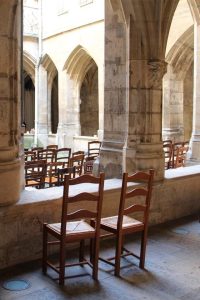Many pilgrims visited the Church and large donations enabled to have a new church built in 1405, to which a cloister and a cemetery were added. The former is the only vestige left, and also the only Middle-Ages cloister to be seen in Paris nowadays.
In 1633 the church was taken over by the Carmelites called Billettes Carmelites. After prolonged negotiations the church was rebuilt from 1754 to 1758 with a Neoclassic façade and a nave with two gallery levels, to the designs of Mansart de Sagonne, Jules Hardouin Mansart’s grandson.
Upon the Revolution the church and convent were sold to private individuals. In 1808 Napoleon had the building bought by City of Paris and assigned to the Consistory of the Lutheran Church.
The interior design dates from the Empire, and then from Louis-Philipp’s reign. The altar and lectern are modern. The organ was manufactured by Mülheisen in Strasbourg and inaugurated in 1983, as testified by a commemorative plaque.
Today the Billettes is a spiritual and cultural centre. The parish has joined the United Protestant Church of France. Lutheran worship is performed every Sunday and evensong on Thursday evenings. The acoustics are impressive. Spiritual concerts are regularly held. In the vestry of the church you can see a collection of donated paintings.
The Lutheran cultural Centre is located in the building next door, 22 rue des Archives. It houses the archives of the former Lutheran Consistory and has a library of books and documents. It organises lectures on various topics intended for a broad audience. It also offers training for lay preachers.
Exhibitions are frequently held in the gallery of the medieval cloister.
Remarquons que les luthériens n’utilisent pas le mot temple pour désigner leurs églises.
The Lutheran Église des Billettes
24 Rue des Archives, 75004 Paris, France



